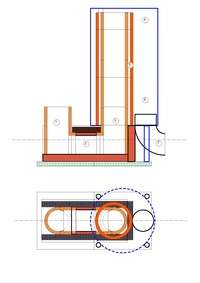Rocket mass heater

A rocket stove mass heater or rocket mass heater, is a space heating system developed from the rocket stove, a type of efficient wood-burning stove, and the masonry heater. Its fundamental characteristics are an insulated combustion chamber where fuel (generally wood) is burned with high efficiency at extremely high temperatures, and a large thermal mass in contact with the exhaust gases which absorbs most of the generated heat before the gases are released to the atmosphere.[1]

In the earliest developed form, wood is gravity fed into a "J-shaped" combustion chamber, from where the hot gases enter a heavily insulated fire-brick or ceramic refractory vertical secondary combustion chamber, the exhaust from which then passes along horizontal metal ducting embedded within a massive cob thermal store. The thermal store is large enough to retain heat for many hours and may form part of the structure of the building. They have proved to be popular with natural buildings and within permaculture designs; they are normally self-built and are not yet recognized by all building codes which regulate the design and construction of heating systems within buildings.
More recent alternate developments have instituted a batch-fed horizontal firebox which feeds into the vertical heat riser or secondary combustion chamber. Also, the horizontal duct flow through the mass may be replaced by a massive "bell" of larger cross section where the hot gases slow and stratify and the cooled gases exit near the bottom as in some masonry heaters. These developments may be used in different combinations in specific instances.
An internal vertical insulated chimney, the combustion chamber, ensures an efficient high-temperature burn and creates enough draft to push exhaust gases through the rest of the system. Flue gases are cooled to a relatively low temperature within the thermal store, approximately 50 °C (122 °F), and steam within these gases condenses into liquid releasing the associated latent heat of condensation, which further increases the efficiency in the manner of a condensing (gas) boiler.[2]
History
The key principles of the rocket (cooking) stove were described in 1982.[3] Ianto Evans of the Cob Cottage Company then described how the same combustion principles could be used to heat a building in his 2006 book, 'Rocket Mass Heaters' based on research and experience in many countries over a 30-year period.[4]
Issues
- Three rocket mass stoves or stove designs has ever been safety certified. The Liberator Rocket Heater, tested to Underwriters Laboratories-1482 safety standard, which is currently on the market, the Eireco Rocket Stove certified in Europe to BS and EN 13240, and Rocket Heater Gamera cirtified to EN 13240. These stoves are also currently on the market.
- Stoves are often self-built to varying dimensions to suit the location and requirements, using a variety of materials.
- Initial lighting of the fire may produce smoke that is often not drawn into the exhaust system until the burning chamber is heated and drawing air.
- A common problem with some designs is "smoke-back", where smoke from the fire is released back into the interior rather than outside. Smoke-back could indicate a serious risk of carbon monoxide poisoning. This issue could be a result of poor individual stove design, or inadequate preheating of the exhaust tube, resulting in inefficient draft to pull the smoke through.
- Rocket mass heater exhaust is cool, around 35 °C, which means in some conditions it is denser than the ambient air. Conventional chimneys may not be suitable for discharge without additional energy inputs.[5] The cool heater exhaust leaves open the question of chimney deposits such as creosote, and reliable measures for cleaning such combustible deposits to reduce the risk of chimney fires. This can be a problem if the rocket mass heater is built incorrectly; the properly built rocket mass heater burns all combustibles in the burn chamber and barrel and the exhaust contains minimal or no combustible properties.
- Horizontal exhaust vents may not be compatible with local building codes
See also
Notes
References
Evans, Ianto & Jackson, Leslie (2004 - 2014). Rocket Mass Heaters, Third Edition. "www.rocketstoves.com." Cob Cottage Co., 2014. ISBN 0-9663738-4-7.
Paul Wheaton's 4 DVD set on Amazon : http://www.amazon.ca/Wood-Burning-Stoves-2-0-Permaculture/dp/B00FBXAFQA
Wheaton, Paul. "rocket stove mass heater" RichSoil.com. Retrieved July 15, 2012.
"Whole stoves". Aprovecho. Retrieved 2009-04-13.
"Book Review – Rocket Mass Heaters – Ianto Evans & Leslie Jackson". Retrieved 2011-04-30.
Mackay, Mary (November 10, 2012), "Stove Really Takes Off", Times Colonist, retrieved June 12, 2014
External links
- Rocket Mass Heaters, the book by Ianto Evans and Leslie Jackson.
- Discussion Forum.
- Ernie and Erica Wisner's site.
- Rocket Stove Mass Heater Tour and How-To includes video samples of 12 heaters and a 10-minute how-to.
- Top Five Things to Do With Oil Barrels When There’s No More Oil To Fill Them – #4. Build a Rocket Stove
- Living with a rocket stove
- Photo gallery of a rocket stove installation
- Eireco rocket stove mass heater.
- Rocket Heater Gamera